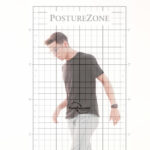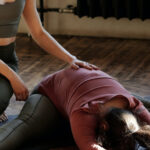What Does Good Posture Look Like?
What does “good posture” look like?
It’s not what you think!
When I ask people about their posture, the most common response is “My posture sucks”. It’s not surprising, because between looking at our devices and sitting, most people today spend the majority of their time with their body folded, rarely opening up to lengthen things fully and stand their tallest.
Studies show sedentary, sitting habits take a significant toll on posture, back pain and health.(1) Diving deeper than “I know it when I see it”- What does “better posture” look like, and why? It’s not the idealized manikins you see, the ones with theoretic dots on the ear, shoulder, hip and ankle because our bodies are different. We’re each subtly unique, which is the problem with solutions to fix posture to be “correct“.
Your posture might not be good, but it’s probably balanced
Sitting or standing, walking or running, watching TV or checking Facebook – if you’re not falling down, your posture is balanced. We’re using muscles and leveraging joints to stay vertical. So the question becomes: What do we see when objectively looking at an individual with functionally stronger posture? Towards vertical is good, but perfectly straight may not be right for that body.
Patient Posture Perception
Which brings us to the more important question- what does it feel like to them? When you try to sit or stand with good posture, does that align with what someone else sees when looking at you? Researchers who objectively aligned people to “ideal” sitting posture found perception didn’t line up with reality. Statistically significant differences were shown between someone’s perception of good sitting posture, and when someone physically and objectively aligned them into “good posture”. (2)
Also and not surprisingly, most people’s habitual sitting posture appears far worse than the posture they assumed for the moment they focused on “good” posture.
These are two elephants standing (or sitting, or walking around) in the room of posture: Awareness and uniqueness. Our internal body awareness, and the actual patterns in which we’re aligning of our body mass in space, are not the same. To function, our physical body must balance- otherwise we fall down.
Posture is Unique
Here’s the bottom line. Everyone’s posture is subtly unique because bodies are shaped differently, and so they balance subtly differently. Which is why improving posture begins with connecting the feeling of “better posture” with how things are truly aligned, the objective reality of things function, the physics of bio-mechanics.
The core of biomechanics is the core… the muscles connecting and controlling the top of our body that sees and manipulates our environment, with the pelvis and lower extremity that gets us around. The key to functionally stronger posture is connecting our body perception more accurately to reality, and engaging accurate core control.
And the best way to begin is by focusing on each body mass, each PostureZone®, and focusing your attention to something objective, something external to your body. Beginning with how your balance your body.
Controlling body balance towards vertical is the beginning of looking at posture because posture is less about how it looks, and more about how it feels and functions. Appearance is a measurement, but we need to look at how that connects to function and control
Which is why we begin the process of retraining posture patterns with StrongPosture® Stork.
- Engage patients with posture rehab. 7 Steps to StrongPosture® is the online at-home program for patients that integrates education and exercise designed to blend easily into your workflow. Find out how you can offer the program to your patients and clients >>>
- Learn the complete rehab protocol and earn CE. Posture and Balance Assessment, Rehabilitation, and Motor Control Exercise >>>





















